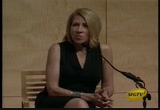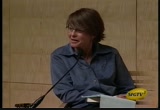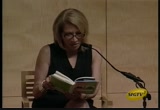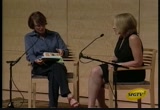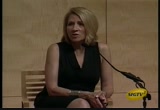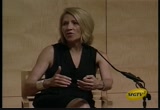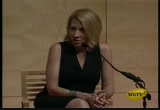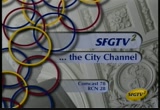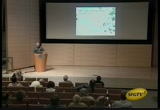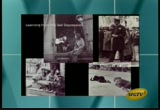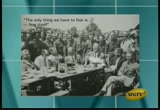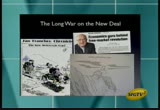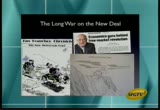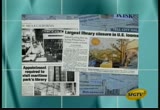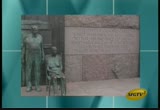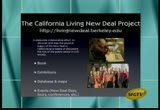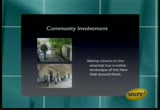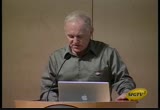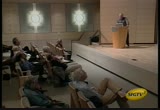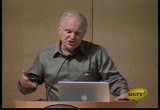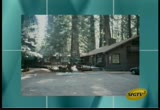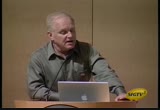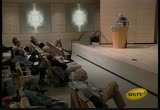tv [untitled] September 24, 2010 4:30am-5:00am PST
5:30 am
happening. we always think we can find a solution to everything and we can't. >> did he teach you that? >> yes. that we sometimes things we can't understand. >> knowing what you know now about how it was all going to play out, would you have done anything differently in the way of ongoing, this will be okay, we'll make this okay, we'll try everything kind of cheer leading? >> i don't think, i would have liked to say i would have been a more buddhist embracing nature. my nature is to be with that younger sister. i think i was trying to mirror what thought he needed.
5:31 am
maybe silence is the way to go. >> this is an odd question, when you said i finally have a brother soon i am going to lose him. why do we love our siblings? >> no one with loves us better. william james often wrote about the core of self. that core of self is hidden from our parents. we hide from our parents but we don't from our siblings, they
5:32 am
know every aspect of us. it is why they can drive us crazy, it is why when we have a problem, our impulse is to want our brother or sister right next to us. no one with could be closer. there is that pull. that pull is so powerful. it was a love story, always. >> do you think you knew that before you started writing this? >> i knew i had to be as close to my brother as i could possibly be. i am sure that pull is part of it. >> you have a daughter and stepson as well? >> i have 1 daughter and 1 stepson who i am close to.
5:33 am
>> has this changed how you are around them as well? >> absolutely. my daughter casey has a half brother she is very close to. i say to all of them, you are a team. you have each other through life. you are a team. you do a lot of things together as the 2 families, very, very close. >> this seems like a good moment to open up any question that is you all may want to ask about the writing process, about siblings, anything else. > is there something you could read to us from the book that you would feel that we wouldn't understand unless you read it? >> you have any ideas? >> it is a real sort of testish.
5:34 am
she has put it together like a quilt. i would say the scene that you described where you are arriving and first see him in the apple orchard, do you remember exactly where that is? >> i'll page through it and see where it is. i might do a short theme where i describe what he looks like and this perfect them. >> if you want to revert to your texas voice. >> the last time i saw my brother, we had an immense fight. it was in his house in san antonio, i am describing, the book opens with this fight. this is sort of a picture of my brother at this exact moment. there are always apples around
5:35 am
him, women, too. apple pie, big sheik antique bowls of wooden apples, read and golden, apples pencils, produce framed on the library wall, texas vegetables from the rio grand empire. i am an american first, then a texan he would say not understanding he sounded like auggi march. the clues are there, i later realized. a man's fate is his character. you always have to show off and tell us what you know, carl said. i'll be in washington next week i say. i have an interview, i have to close of peace.
5:36 am
you promised me, you said you would stay away from washington state. you sat right here and said you would not go to the cascades. he yells as loudly as i have ever heard him. washington, d.c. i shout back. i have the trait as well. [laughter]. >> as you are thinking about that, i would like to ask you to give us one more. there are 2 completely surprising and interesting substories woven through this narrative of your brother, 1, your fabulous aunt character in mexico getting frosty into mexico and running around with frita caller and your discovery of apples? >> this is astonishing, are we
5:37 am
talking about the family past apple? >> both and the way thing danagers come together, yeah. >> kind of astonishing, again working on the idea that everything is passed down in families is it or is it not or is it coincidence. my father had a difficult relationship with his father from mexico. we knew our family had this chain of nurseries from mexico. i never understood because my father would change tg subject when his name came up. our grandfather was an orchardist at the turn of the century. >> which you hadn't even known. >> i didn't know it until i discovered this at the archive
5:38 am
when i was trying to page through all of these things. then i discovered an obituary that had been written about our grandfather when he died when we were much to young to remember him. it was very, very long in the texas at the time. it detailed every, all the rare plants, specimen plants, horticultural, introducing them to texas. i was so excited about all of this. i used to say to my brother, this apple thing, you have gotten from your grandfather who had a reverence. he would say that is ridiculous.
5:39 am
when my brother announced he was going to give up his life as a trial lawyer to be an apple orchardist. my father said i have one thing to say, jews don't farm. but they did. his father clearly did. >> just to wind up, then, what are you working on next? >> i have become fascinated with the personal. this is the most excruciating difficult book. >> so you are going to turn around and do it again. >> i have been spending a great deal of time in india every year my next book is a memoir of going through india and what this has done to transform my own life. >> thank you very much.
5:41 am
let me tell you about the project and a lot about san francisco and by the end of this, you're going to feel like you have been buried about the new deal. i am only scratching the surface. i haven't even gotten through it. it's terrific. i recommend that is supplementary reading. homework assignment that you have to do that. i am going to tell you about the living new deal project and a lot of stuff that got done in san francisco and various other places as well, too. we have to really learn from the last great depression. because, in fact, we might be having another one soon.
5:42 am
the great depression was photo. the farm security division which turned good photographers into great ones. berkeley photographer dorothy alang. these give you an idea of just how apalling bad the great reh depression was. the best we have, as well as movies, it's difficult to million how it was. we tend to look back through the safety net, which was created by the new deal. it was very difficult for young people to understand a time when there was no social safety net. when you lost your job, within
5:43 am
a short period of time, you lost your home, food, everything. you were out on the street and your family broke up. it was an apalling time. one tow which some people would like us to return. here's a guy himself, that's actually a light bounce off of fdr roosevelt. this was his chakra. this was march 4th, 1933. he made the statement and he made it, i didn't understand a long time. the point i was making, people were terrified. because it seemed like the economy had no bottom and the
5:44 am
banks were going down and there was no federal deposit dollars. so imagine a time when we actually had a president who told us we should be courageous rather than trafficked in fear. to his own advantage. there's been a long war on the new deal. it was when roosevelt got started. almost immediately, the more than great realized the lengths he was willing to go. at the beginning, roosevelt didn't understand how far he was going to go. the dupont family and the ones that set up the american
5:45 am
liberty league. that was successful because they have unlimited amounts of money. there were so popular, they were not able to stop it. they began to finance right-wing think tanks. they have been successful to the university of chicago economics department and notable fraud such as milton freed man. the idea of neoliberalism is there should be massive, selective tax cuts. margaret thatcher it is there is no alternative. of course that's absurd. there was an alternative.
5:46 am
we have to connect the dots to understand what is going on today. i read the chronicle. so what i've done is put together a montage of the murder of public sector, which is going on everyday. in fact all of the public sector is in body shape. public libraries, parks from the municipal to the national level. our character is among the worst in the world. the new deal deals with things in a different way. when i was going to school,
5:47 am
california school's were the best. now they are among the worst with the new budget cuts. of course, my university is being privatized. all of the higher education is being privatized. all through the uc system. how do you run a modern state with tax cuts? we resort to desperate, back last november, we were asked to vote to make four indian casinos in san diego county pony up money. i thought this was a joke. they voted to do it. now, the governor proposes to
5:48 am
borrow against future revenues. how did they deal with these social problems when the economic problems were far worse than what we can imagine today? this is from larry halprin's. and it has these quotes from roosevelt on the wall. he said in one of his talks to the people, "the test is not whether we have more, it is whether we provide enough for those who have too little". it's a different philosophy than that which we have become used to. what i am going to show you is a lost civilization. it's a strange place.
5:49 am
and yet, it becomes oddly familiar after a while because we built it and use it every day without knowing it. it has been buried. the living new deal project is like an archaeological dig. we are going after the new deal in california, but hope to extend throughout the united states. i thought that i am, photographer robert dosson could photo. it's gradually become a collaborative prejudice, which is state wide and is being sponsored by the california historical society for research and labor employment at berkeley. this is part of the team.
5:50 am
part of it is community involvement. we want people to become aware of what's around them. the records are terrible. he lives up nevada city. i told him what i was doing and he was consciencious. he had a stack of clippings about what the new deal had done in his area and walked around while he showed me sidewalks and parks and schools and gardens and camps that had been done. he said, i didn't notice.
5:51 am
then he became mayor. it's exactly the kind of thing we want. this is or was the living new deal site about a couple months ago. it's much denser now. san francisco county is the best documented of all the california counties. we think that all of california will look like san francisco now. when you begin putting in the work of the civilian conservation core, you find it's everywhere. we are talking about a lot of agencies. roosevelt loved building things. he was the lord of the manor at hyde park. it shows roosevelt in his convertible.
5:52 am
if you visit there, you could see he could drive using the upper part of his body. he's pointing to the plans of the hyde park. he was quite a passable architect. once he became president, he was able to build a lot more. even though henry loose was generally opposed to roosevelt. we ran a double page on his to show how the work he had done. i couldn't get it all on my standards. in the west, you would see without the new deal projects,
5:53 am
the republican voting sun belt cities wouldn't exist. they were built at that time. so, it's as i say. there was at least a dozen agencies that left remnants. i am going to give you a primer on all of these. the premise was to put people to work. there were agencies that covered all of these. the land had been ruinned by a variety of things. this is one of the posters and these are archival photographs. this shows the ccc boys. many of them had been riding the rails. they were starving.
5:54 am
they were illiterate. here they are in one of the camps, which were run by the army and it was like a military organization. they were out in the wilderness. you could leave if you wanted to. this was a civilian conservation core. this is not trickle down next. in fact, it worked. it began to float local economies. they did an enormous amount of work. they wanted millions of trees. i looked over into alabama across a great forest of trees that were 70 years old.
5:55 am
they're planted in huge numbers. imagine the kind of wildlife that becomes. they did an enormous amount of work and when the war was here, there was ready to go fight. this was not what this was intended to do. there are a few statues. they built a lot of lodges and visitor centers. these are just beautiful. amount of landscapes of ccc. this is the park. they did the work in them. the civil works administration
5:56 am
was short lived. it was to get the people through the winter. and it was under the administration of a remarkable social worker from iowa named hary hopkins. he was the forerunner of the wpa and the prototype for it. this is a page from the cw a and it showed kids getting hot lunches. that was important. he put 2 million americans to work. and that included about 50
5:57 am
thousand school teachers sent out to rural areas. this is a cw a project. that's stern grove behind it. they are using wheel barrels. for this reason, many projects were well built. there are no cw a plot. this was one in berkeley placed there and the tennis court at coat niecis park. i was showing a montessory class there. this is an amphitheatre. it's a wonderful amphitheatre. there was from the sidewalks
5:58 am
and they just reused it to create other things. down in menlow park. they built into a caretakers house. the wpa is must more famous. it came after the cw a. it did everything. they put eight and a half million people to work. they built roads. they sewed clothes. they built roads is in san francisco. this one, i have seen them on sidewalks in san francisco. this is on a retains wall in crocket. they are very seldom markers.
5:59 am
cw a doesn't. pw a, almost never. not nearly commiserate with what they were doing. that's one of the restrooms in golden gate park. that's a plaque, carefully hidden. the gardeners prune the vine so you can have a chance of finding it. here's one at park and mont clar. they are using a facility that was built by that. finally, the public works is not well known,
112 Views
IN COLLECTIONS
SFGTV2: San Francisco Government Television Television Archive
Television Archive  Television Archive News Search Service
Television Archive News Search Service 
Uploaded by TV Archive on

 Live Music Archive
Live Music Archive Librivox Free Audio
Librivox Free Audio Metropolitan Museum
Metropolitan Museum Cleveland Museum of Art
Cleveland Museum of Art Internet Arcade
Internet Arcade Console Living Room
Console Living Room Books to Borrow
Books to Borrow Open Library
Open Library TV News
TV News Understanding 9/11
Understanding 9/11

